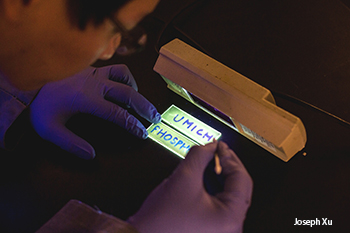
Min Sang Kwon demonstrates how the PhOLED changes color by writing on it with a water-soaked pen under 365-nm UV light.
A team of materials scientists at the University of Michigan, U.S.A., have designed a low-cost organic polymer material that phosphoresces at room temperature. Associate Professor of materials science and engineering Jinsang Kim and his colleagues created efficient phosphorescent organic light-emitting diodes (PhOLEDs) that are cheaper to produce than other metal-based organic phosphors and are less toxic (Angw. Chem., doi:10.1002/anie.201404490).
To produce LEDs that are more efficient and metal-free, Jinsang and his team took inspiration from the Hope diamond, which is blue in tint but phosphoresces red under ultraviolet light due to traces of boron in its carbon structure. Whereas organic semiconductors suffer vibrations that dissipate energy as heat into the surrounding material instead of into phosphorescence, the team conceived of an amorphous polymer matrix, which, like the stiff crystalline lattice in a diamond, would stifle the vibrations and allow more glowing. The trick was to use a purely organic material that would provide rigidity with less effort.
The team tweaked the molecule design of the metal-free semiconductor molecules and a transparent polymer matrix of polyvinyl alcohol so that they bond together.
“Increasing the intermolecular bonding strength efficiently suppresses the vibrational loss due to heat of the phosphorescence,” said Kim.
The material allows a high phosphorescence quantum yield of 24 percent at room temperature. The material, which glows green when exposed to ultraviolet light, is also sensitive to the presence of water. When exposed to water, the polymers dissolve, changing the green phosphorescence to blue fluorescence. Such a material could be used in simple sensors that can detect water. Applications for such a sensor would include, for example, dentistry, in which dentists need to know when a tooth is entirely dry before filling a cavity. The presence of even a small amount of water would turn the material from green to blue.
In addition to these radiometric water sensors, the material might someday enable more efficient organic LEDs or solid-state lighting.
